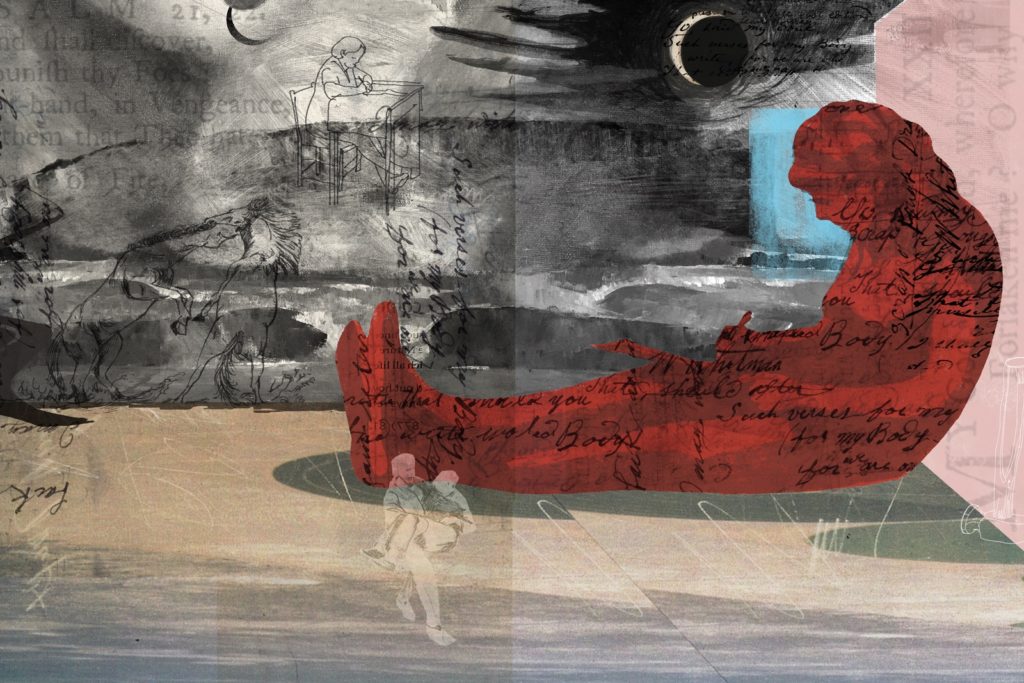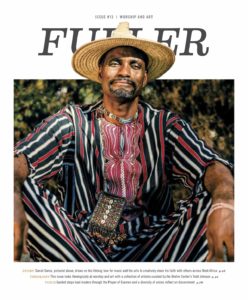
The catastrophic.
It’s the starting point for any theology worth its salt.
In fact, if Christian theology is unable to address the core traumas that haunt the contemporary cultural imagination, it might as well say nothing at all.
These were only a few of the thoughts running through my heart and mind one Sunday morning at church not too long ago. Our congregation was singing songs of worship like we always do, and as is often the case, my wife and I were standing with our daughters in the row just behind our good friend and her three young children.
Still, this Sunday was different than most. After enduring a battery of tests, radiation treatments, chemotherapy, and a stem-cell transplant, our friend’s leukemia, which had been in remission for nearly two full years, had now returned. And no amount of singing would change that.
Of course, because of their age, neither her children nor ours were fully aware of what it all meant. So while they laughed and sang together and misbehaved as they did nearly every other Sunday morning, we mostly cried.
No. We wept.
Interestingly enough, our weeping didn’t stop us from singing, but it did color the music in a discernible way. Namely, instead of proclamation, the words we sang shifted into a form of divine interrogation:
And all the earth will shout your praise
Our hearts will cry, these bones will sing
Great are you, Lord
Really? Are the bones of this woman a testament to God’s greatness—the woman suffering from cancer in her bone marrow? Will the earth—should the earth—shout praises to a God who would rob her three young children of their mother? As the congregation sang this stanza over and over again, it became clear that we were no longer stating anything; we were questioning everything. It wasn’t “Great are you Lord!” It was “Are you great, Lord?” Our praises had become laments in their offering.
We weren’t the only group of Christians who had gathered together that day to sing songs to a God who seemed to be impotent, or indifferent, or just plain absent in the face of tragic circumstances. Rather, through music, poetic utterance, and corporate singing, we were bringing to speech what countless other women and men of faith were also voicing on that otherwise unremarkable Sunday morning. In concert with this great cloud of witnesses, we drew upon the power of metaphor and poetry to articulate a “groaning too deep for words” (Rom 8:26)—an elemental cry of desperation, borne from an experience of the catastrophic, aimed directly at the Divine.
A strikingly similar cry of lament crossed the lips of Jesus himself while hanging on the cross: “My God, my God, why have you forsaken me?” (Mark 15:33; Ps 22:1). Jesus was quoting Psalm 22, but surely he wasn’t proof-texting. Rather, he was articulating in poetic form the central trauma around which the entire theological project turns: divine abandonment. On the cross, the Father really does forsake the Son. Somehow, and in some way, God apostatizes against God’s self.
Wait a minute. That can’t be right, can it? Are we really supposed to take Jesus at his word here? There is of course no easy answer to this question, but Paul calls the cross a “scandal” for a reason (1 Cor 1:23), and it isn’t simply because the idea of God abandoning God is logically counterintuitive. Instead, as Jürgen Moltmann has suggested, the scandal of Jesus’ experience of god-forsakenness is that it makes theologians out of us all—believer and unbeliever alike:
[I]s not every unbeliever who has a reason for his atheism and his decision not to believe a theologian too? Atheists who have something against both God and faith in God usually know very well whom and what they are rejecting, and have their reasons. Nietzsche’s book The Antichrist has a lot to teach us about true Christianity, and the modern criticism of religion put forward by Feuerbach, Marx and Freud is still theological in its anti-theology. Beyond that, moreover, there is a protest atheism which wrestles with God as Job did, and for the sake of the suffering of created beings which cries out to high heaven denies that there is a just God who rules the world in love. This atheism is profoundly theological, for the theodicy question—If there is a good God, why all this evil?—is also the fundamental question of every Christian theology which takes seriously the question that the dying Christ throws at God: “My God, why have you forsaken me?”1
For some time now, my colleague Barry Taylor and I have been exploring this very notion—that something profoundly theological might be taking place in the name of atheism. In doing so, we have stumbled upon a somewhat surprising realization— that something scandalously “atheological” is also taking place in the name of theology. The only problem is that we need a new set of lenses to see it, much less come to grips with its many implications.
So we have embarked on a quest to find new conversation partners for theology. Along the way, we have focused very little energy on the “New Atheists”—that small group of outspoken atheists whose faith in scientism and staunch commitment to diatribe over dialogue would rival that of any religious fundamentalist. Instead, we’ve been far more energized by what Simon Critchley (himself an atheist) has called the “faith of the faithless” and what Alain de Botton (also an atheist) describes as “Religion for Atheists.”
Given our broader interests in the theological significance of art, aesthetics, and popular culture, the working title for our project is “The Aesthetics of A/theism.”2 The primary aim of this project is to demonstrate what it looks like to engage in a robust, mutually enriching conversation with atheist artists and contemporary cultural artifacts, not simply because they offer us a concrete point of departure for theological reflection, but also because there is something about art and aesthetic experience that is integral to the entire atheological enterprise. Which brings us back to Jesus’ cry on the cross.
As Jesus’ death by crucifixion demonstrates, the juxtaposition of seemingly incompatible ideas (e.g., God forsaking God) is often too counterintuitive, too radical, too challenging for our staid sensibilities. It’s partly why people almost always misunderstand what Jesus is saying, especially religious folks. His final words of apostasy are no different. In spite of the fact that he is quoting well-known Scripture, it seems that no one within earshot has any idea what Jesus is talking about: “He must be calling for Elijah. Yes, let’s see if Elijah comes to rescue him!” (Mark 15:35–36) It may also be why, for everyone who was not a firsthand witness to these events, the only appropriate response to the death of God was, is, and continues to be art, music, image, and narrative. Indeed, there has been no shortage of artworks focused on the crucifixion, whether historically speaking or in our post-theistic context. And it is likely because there really is no better (or other) mode by which humans might capture, express, and otherwise explore such a profound incongruity than in and through these poetic means.
In other words, both the death of God and the divine apostasy it entails expose the limits of any theology that exclusively employs syllogistic reasoning or deductive logic. Approaching Jesus’ cry on the cross in this way is like attempting to determine how much a piece of music weighs. It’s a category mistake. Along similar lines, to suggest that, in the crucifixion, God became an atheist—even if for a moment—is not to accuse the Father or Son of blasphemy, nor is it to dabble in illogical untruths that lead to some other kind of heresy. It is rather to reject the logic of the atheism/theism polarity altogether, acknowledging instead that a distinct kind of poetics resides within the heart of the Christian faith—a mood or sensibility toward life that seeks new coordinates in the wake of the death of God.
G. K. Chesterton made a similarly subversive claim in his aptly titled Orthodoxy:
When the world shook and the sun was wiped out of heaven, it was not at the crucifixion, but at the cry from the cross: the cry which confessed that God was forsaken of God. And now let the revolutionists choose a creed from all the creeds and a god from all the gods of the world, carefully weighing all the gods of inevitable recurrence and of unalterable power. They will not find another god who has himself been in revolt. Nay (the matter grows too difficult for human speech), but let the atheists themselves choose a god. They will find only one divinity who uttered their isolation; only one religion in which God seemed for an instant to be an atheist.3
If Chesterton is correct (and I think he is), then the core event of Christianity is not so much a demonstration of supreme faith, but of divine abandonment. As such, it constitutes what Paul Ricoeur might call a “concordant discordance.” It is neither logical nor illogical, but rather paralogical. And it is for this very reason that both theology and atheism need poetry and metaphor. They need aesthetics, for they are both inherently trafficking in matters “too difficult for human speech” as Chesterton says. Propositional language alone simply proves inadequate for navigating these complex realities. Which means that, taken from the perspective of the divine paralogic of the cross, what is truly heretical is not apostasy per se, but any attempt to “make sense of,” “rationalize,” or otherwise “logically explain” Jesus’ despairing cry to the God who had so obviously forsaken him.
Many strong and loud voices would have us believe otherwise—that matters of faith are simple and straightforward and that we all exist at one or the other end of a very clear polarity. Either we are orthodox “believers” or heterodox “non/unbelievers,” “faithful” or “faithless,” “theists” or “atheists.” The recent return of both secular and religious forms of fundamentalism has only made this polarization worse. The New Atheists may not believe in the God of radicalized religious sects, but they share the same penchant for absolutizing their claims to knowledge and truth over and against all those who see the world differently. It’s no small wonder that both camps are often referred to as “militant,” for to them, we are all at war. But to offer up a lament in the form of a faithful protest isn’t to be at war with anyone, especially not with people whose anguished cries simply emerge from a different religious (or nonreligious) standpoint than our own. Rather than set us at odds with one another, the catastrophic poetry of the cross invites each and every one of us to enter a space in which despair and faith meet, a space where the “faith-ful” and the “faith-less” are neither enemies nor opponents, but fellow sojourners.
Put differently, whether we are “believers” or not, life’s meaning remains elusive and opaque—always just out of reach. And that’s why, when my little community of faith discovered that one of our own would once again have her life turned upside down by cancer, all we could do was cry out in song. We sang not because it alleviated our fears or distracted us from the unanswered questions that continued to plague us, but because speaking in propositional terms would have been a category mistake. It would have been offensive, possibly even heretical. In any other context, our words would have been words of praise, but in this context, they became a form of “protest atheism”—a railing against the god-forsakenness of the world. We joined our sister in song on that day for the same reason that Jesus chose poetry rather than prose for his last words: because some tragedies are simply unspeakable. To adapt that well-known exclamation from Mark 9:24: “We believe; God, help our unbelief!”
The catastrophic. It’s more than a starting point. It’s the constitutive feature of any faith modeled on the cross—that world-shattering event where Jesus not only uttered our isolation in the form of poetry, but also, even if just for a moment, was an atheist too.


